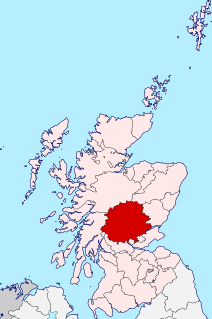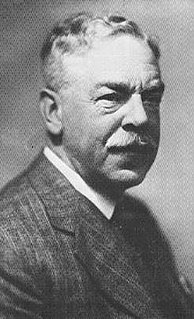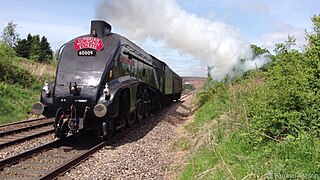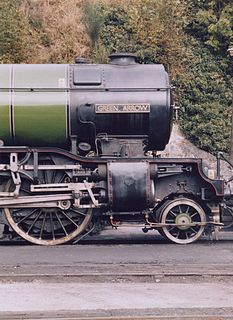Related Research Articles

Perthshire, officially the County of Perth, is a historic county and registration county in central Scotland. Geographically it extends from Strathmore in the east, to the Pass of Drumochter in the north, Rannoch Moor and Ben Lui in the west, and Aberfoyle in the south; it borders the counties of Inverness-shire and Aberdeenshire to the north, Angus to the east, Fife, Kinross-shire, Clackmannanshire, Stirlingshire and Dunbartonshire to the south and Argyllshire to the west. It was a local government county from 1890 to 1930.

The Class A4 is a class of streamlined 4-6-2 steam locomotive designed by Nigel Gresley for the London and North Eastern Railway in 1935. Their streamlined design gave them high-speed capability as well as making them instantly recognisable, and one of the class, 4468 Mallard, holds the world record as the fastest steam locomotive. Thirty-five of the class were built to haul express passenger trains on the East Coast Main Line route from London Kings Cross via York to Newcastle, and later via Newcastle to Edinburgh, Scotland. They remained in service on the East Coast Main Line until the early 1960s when they were replaced by Deltic diesel locomotives; they themselves proving to be worthy successors to the A4s. Several A4s saw out their remaining days until 1966 in Scotland, particularly on the Aberdeen – Glasgow express trains, for which they were used to improve the timing from 3.5 to 3 hours.

Sir Herbert Nigel Gresley was a British railway engineer. He was one of Britain's most famous steam locomotive engineers, who rose to become Chief Mechanical Engineer (CME) of the London and North Eastern Railway (LNER). He was the designer of some of the most famous steam locomotives in Britain, including the LNER Class A1 and LNER Class A4 4-6-2 Pacific engines. An A1 Pacific, Flying Scotsman, was the first steam locomotive officially recorded over 100 mph in passenger service, and an A4, number 4468 Mallard, still holds the record for being the fastest steam locomotive in the world (126 mph).

Whyte notation is a classification method for steam locomotives, and some internal combustion locomotives and electric locomotives, by wheel arrangement. It was devised by Frederick Methvan Whyte, and came into use in the early twentieth century following a December 1900 editorial in American Engineer and Railroad Journal.

The steam locomotives of British Railways were used by British Railways over the period 1948–1968. The vast majority of these were inherited from its four constituent companies, the "Big Four".
The London and North Eastern Railway (LNER) produced several classes of locomotive, mostly to the designs of Nigel Gresley, characterised by a three-cylinder layout with a parallel boiler and round-topped firebox. It produced the most famous locomotive of its day, 4468 'Mallard', the holder of the world steam locomotive speed record. It also built the world-famous 4472 'Flying Scotsman'. However, its locomotive inheritance was much greater than just the 'A4 Class', it also produced highly successful mixed-traffic and freight designs.
Under the Whyte notation for the classification of steam locomotives, 0-8-0 represents the wheel arrangement of no leading wheels, eight powered and coupled driving wheels on four axles and no trailing wheels. Locomotives of this type are also referred to as eight coupled.

60009 Union of South Africa is a LNER Class A4 steam locomotive built at Doncaster Works in 1937. It is one of six surviving A4s. Its mainline certification expired in April 2020. As the locomotive is subject to a boiler inspection, it was moved to the East Lancashire Railway until 2022, when it will be permanently withdrawn and placed on static display. It was briefly renamed Osprey during part of the 1980s and 1990s due to political opposition against apartheid in South Africa at the time.

4464Bittern is a London & North Eastern Railway Class A4 steam locomotive. Built for the LNER in 1937 at Doncaster Works as works number 1866, it was originally numbered 4464. Renumbered 19 on 16 August 1946 under the LNER 1946 renumbering scheme, it was renumbered 60019 by British Railways on 10 October 1948, after nationalisation. A Pacific 4-6-2 locomotive to the same design by Nigel Gresley as the more famous A4 Mallard and one of the 35 strong class, it is one of six to survive into preservation but is one of only two currently scheduled to be certified for mainline use.

The London and North Eastern Railway (LNER) Peppercorn Class A1 is a type of express passenger steam locomotive. Forty-nine original Peppercorn Class A1s were built to the design of Arthur Peppercorn during the early British Railways era, but all were scrapped with the discontinuation of steam, with none of the original production run surviving into preservation. In 2008, a brand new 50th Peppercorn A1 locomotive, 60163 Tornado, was completed.

The Gresley conjugated valve gear is a valve gear for steam locomotives designed by Sir Nigel Gresley, chief mechanical engineer of the LNER, assisted by Harold Holcroft. It enables a three-cylinder locomotive to operate with only the two sets of valve gear for the outside cylinders, and derives the valve motion for the inside cylinder from them by means of levers. The gear is sometimes known as the Gresley-Holcroft gear, acknowledging Holcroft's major contributions to its development.

The London and North Eastern Railway (LNER) Class K4 is a class of 2-6-0 steam locomotives designed by Nigel Gresley for the steep grades of the West Highland Line.

Dugald Drummond was a Scottish steam locomotive engineer. He had a career with the North British Railway, LB&SCR, Caledonian Railway and London and South Western Railway. He was the older brother of the engineer Peter Drummond, who often followed Dugald's ideas in his own work.
The Scottish Region (ScR) was one of the six regions created on British Railways (BR) and consisted of ex-London, Midland and Scottish Railway (LMS) and ex-London and North Eastern Railway (LNER) lines in Scotland. It existed from the creation of BR in 1948, and was renamed to ScotRail in the mid-1980s.

LNER Peppercorn Class A1 No. 60163 Tornado is a 4-6-2 steam locomotive completed in 2008 to an original design by Arthur Peppercorn. It is the first newly built British mainline steam locomotive following the completion of No. 92220 Evening Star in 1960, and the only Peppercorn Class A1 in existence after the original batch was scrapped. In 2017, Tornado became the first steam locomotive to officially reach 100 mph on British tracks for over 50 years.

The Top Gear Race to the North was a three-way race held in 2009 between a Jaguar XK120 car, a Vincent Black Shadow motorcycle, and railway locomotive 60163 Tornado – a brand new mainline steam engine completed in Britain in 2008. The race saw the car, bike and locomotive, race from London, England, to Edinburgh, Scotland, a journey of around 400 miles (640 km). Eighteen months in the planning, the race was filmed in secret on 25 April 2009, and shown on 21 June 2009 on the UK's top rated motoring programme, Top Gear.

The NBR S Class is a class of 0-6-0 steam locomotive designed by William Paton Reid for freight work on the North British Railway. The engines were initially designated as B class, being a development of the standard B class locomotives designed by Reid some eight years previously, and represented the culmination of a long evolution on the NBR of powerful 0-6-0 freight engines. The new locomotives were introduced in 1914 and had superheaters, inside cylinders and piston valves operated by Stephenson valve gear.
The East Fife Central Railway was a mineral railway line in Fife, Scotland, that ran from near Leven to Lochty. It was intended to develop extensive coal measures in the area, but in fact they proved to be uneconomic. The line was completed by the North British Railway and it opened in 1898.

The Devon Valley Railway linked Alloa and Kinross in central Scotland, along a route following the valley of the River Devon. Its construction took 20 years from the first section opening in 1851, to the final section in 1871. Three railway companies were involved, and it encountered a great many problems both with finance and engineering.

LNER 3442 The Great Marquess is a member of the London and North Eastern Railway (LNER) Class K4 designed by Nigel Gresley for the steep grades of the West Highland Line. It was renumbered 1994 in the LNER's 1946 renumbering scheme, and then renumbered 61994 by British railways after the 1948 nationalisation of Britain's railways.
References
- ↑ "EU's largest sheep farmer sells bulk of his Scottish farm". Farmers Weekly Interactive. 11 January 2006. Archived from the original on 3 August 2012. Retrieved 18 December 2008.
- 1 2 "Major sell-off by John Cameron". Tayside Courier. 19 December 2008. Archived from the original on 20 May 2008.
- ↑ "Bogus sheep farmer impersonated landowner and fleeced his namesake's estate out of £400,000". 2 October 2014.
- ↑ Cameron joins Stagecoach The Railway Magazine issue 1131 July 1995 page 64
- ↑ "Advisiory Board". tri-napier.org. Archived from the original on 9 January 2011. Retrieved 18 December 2008.
- ↑ "SWT name its new Bubble car" Entrain issue 43 July 2005 page 52
- ↑ Devereux, Nigel (10 February 2017). "Cameron 'A4' and 'K4' are not for sale – 'at any price'". The Railway Magazine. Retrieved 7 December 2018.
- ↑ "14-month extension for 'Nine' - and a busy 2019 lies ahead". Steam Railway (491): 48.
- ↑ ELR announces final running dates for Union of South Africa Heritage Railway issue 282 July 2021 page 7
- ↑ "They think it's all over...it is now: 'Number Nine' bows out". Steam Railway (524): 14.
- ↑ "Cameron Travel Scholarship Trust" (PDF). Dollar Academy. Retrieved 18 December 2008.[ dead link ]